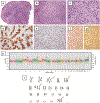Molecular characterization of localized pleural mesothelioma
- PMID: 31371807
- PMCID: PMC7359734
- DOI: 10.1038/s41379-019-0330-9
Molecular characterization of localized pleural mesothelioma
Abstract
Localized pleural mesothelioma is a rare solitary circumscribed pleural tumor that is microscopically similar to diffuse malignant pleural mesothelioma. However, the molecular characteristics and nosologic relationship with its diffuse counterpart remain unknown. In a consecutive cohort of 1110 patients with pleural mesotheliomas diagnosed in 2005-2018, we identified six (0.5%) patients diagnosed with localized pleural mesotheliomas. We gathered clinical history, evaluated the histopathology, and in select cases performed karyotypic analysis and targeted next-generation sequencing. The cohort included three women and three men (median age 63; range 28-76), often presenting incidentally during radiologic evaluation for unrelated conditions. Neoadjuvant chemotherapy was administered in two patients. All tumors (median size 5.0 cm; range 2.7-13.5 cm) demonstrated gross circumscription (with microscopic invasion into lung, soft tissue, and/or rib in four cases), mesothelioma histology (four biphasic and two epithelioid types), and mesothelial immunophenotype. Of four patients with at least 6-month follow-up, three were alive (up to 8.9 years). Genomic characterization identified several subgroups: (1) BAP1 mutations with deletions of CDKN2A and NF2 in two tumors; (2) TRAF7 mutations in two tumors, including one harboring trisomies of chromosomes 3, 5, 7, and X; and (3) genomic near-haploidization, characterized by extensive loss of heterozygosity sparing chromosomes 5 and 7. Localized pleural mesotheliomas appear genetically heterogeneous and include BAP1-mutated, TRAF7-mutated, and near-haploid subgroups. While the BAP1-mutated subgroup is similar to diffuse malignant pleural mesotheliomas, the TRAF7-mutated subgroup overlaps genetically with adenomatoid tumors and well-differentiated papillary mesotheliomas, in which recurrent TRAF7 mutations have been described. Genomic near-haploidization, identified recently in a subset of diffuse malignant pleural mesotheliomas, suggests a novel mechanism in the pathogenesis of both localized pleural mesothelioma and diffuse malignant pleural mesothelioma. Our findings describe distinctive genetic features of localized pleural mesothelioma, with both similarities to and differences from diffuse malignant pleural mesothelioma.
Conflict of interest statement
Figures




Similar articles
-
Inactivation of Bap1 Cooperates with Losses of Nf2 and Cdkn2a to Drive the Development of Pleural Malignant Mesothelioma in Conditional Mouse Models.Cancer Res. 2019 Aug 15;79(16):4113-4123. doi: 10.1158/0008-5472.CAN-18-4093. Epub 2019 May 31. Cancer Res. 2019. PMID: 31151962 Free PMC article.
-
Molecular characterization of diffuse malignant peritoneal mesothelioma.Mod Pathol. 2020 Nov;33(11):2269-2279. doi: 10.1038/s41379-020-0588-y. Epub 2020 Jun 5. Mod Pathol. 2020. PMID: 32504035
-
Fluorescence in situ hybridization (FISH) provides estimates of minute and interstitial BAP1, CDKN2A, and NF2 gene deletions in peritoneal mesothelioma.Mod Pathol. 2020 Feb;33(2):217-227. doi: 10.1038/s41379-019-0371-0. Epub 2019 Sep 30. Mod Pathol. 2020. PMID: 31570769
-
Pleural mesothelioma classification-update and challenges.Mod Pathol. 2022 Jan;35(Suppl 1):51-56. doi: 10.1038/s41379-021-00895-7. Epub 2021 Aug 31. Mod Pathol. 2022. PMID: 34465883 Review.
-
Characterizing the distribution of alterations in mesothelioma and their correlation to morphology.Am J Clin Pathol. 2023 Sep 1;160(3):238-246. doi: 10.1093/ajcp/aqad041. Am J Clin Pathol. 2023. PMID: 37141416 Review.
Cited by
-
Genetic Pathways in Peritoneal Mesothelioma Tumorigenesis.Cancer Genomics Proteomics. 2023 Jul-Aug;20(4):363-374. doi: 10.21873/cgp.20388. Cancer Genomics Proteomics. 2023. PMID: 37400148 Free PMC article.
-
Diagnostic Challenges in Epithelioid Pleural Mesothelioma: Case Series with Support from Electron Microscopy.Diagnostics (Basel). 2021 May 7;11(5):841. doi: 10.3390/diagnostics11050841. Diagnostics (Basel). 2021. PMID: 34067170 Free PMC article.
-
Adenomatoid tumours of the gastrointestinal tract - a case-series and review of the literature.Histopathology. 2022 Jan;80(2):348-359. doi: 10.1111/his.14553. Epub 2021 Oct 7. Histopathology. 2022. PMID: 34480486 Free PMC article. Review.
-
Diffuse Pleural Mesotheliomas with Genomic Near-Haploidization: A Newly Recognized Subset with Distinct Clinical, Histologic, and Molecular Features.Clin Cancer Res. 2024 Jul 1;30(13):2780-2789. doi: 10.1158/1078-0432.CCR-24-0085. Clin Cancer Res. 2024. PMID: 38630790 Free PMC article.
-
Chromosomal alteration patterns in PitNETs: massive losses in aggressive tumors.Endocr Relat Cancer. 2024 Dec 19;32(1):e240070. doi: 10.1530/ERC-24-0070. Print 2025 Jan 1. Endocr Relat Cancer. 2024. PMID: 39441837 Free PMC article.
References
-
- Churg A, Roggli V, Chirieac LR, Galateau-Salle F, Borczuk AC, Dacic S, et al. Tumours of the pleura. Mesothelial tumours. Localized malignant mesothelioma In: Travis WD, Brambilla E, Burke A, Marx A, Nicholson AG, editors. World Health Organization Classification of tumors pathology and genetics of tumors of the lung, pleura, thymus, and heart. 4th edn Lyon, France: IARC Press; 2015. p. 170.
-
- Allen TC, Cagle PT, Churg AM, Colby TV, Gibbs AR, Hammar SP, et al. Localized malignant mesothelioma. Am J Surg Pathol. 2005;29:866–73. - PubMed
-
- Okike N, Bernatz PE, Woolner LB. Localized mesothelioma of the pleura: benign and malignant variants. J Thorac Cardiovasc Surg. 1978;75:363–72. - PubMed
-
- Crotty TB, Myers JL, Katzenstein AL, Tazelaar HD, Swensen SJ, Churg A. Localized malignant mesothelioma. A clinicopathologic and flow cytometric study. Am J Surg Pathol. 1994;18:357–63. - PubMed
-
- Nakano T, Hamanaka R, Oiwa K, Nakazato K, Masuda R, Iwazaki M. Localized malignant pleural mesothelioma. Gen Thorac Cardiovasc Surg. 2012;60:468–74. - PubMed
MeSH terms
Substances
Grants and funding
LinkOut - more resources
Full Text Sources
Miscellaneous

